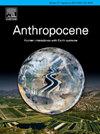Patagonia's Late Holocene lake sediments reveal no major black carbon sources for Antarctica
IF 3.3
2区 地球科学
Q2 ENVIRONMENTAL SCIENCES
引用次数: 0
Abstract
Black carbon from biomass and fossil fuel burning is an important aerosol in the climate system. Understanding its historical variation is crucial to constrain current anthropogenic and wildfire impacts on the atmosphere. Patagonia was proposed previously as a major source region for the late 13th century black carbon increase observed in an ice core from the northern Antarctic Peninsula but not in continental Antarctic ice cores. Here, we reconstruct regional black carbon trends using high-resolution measurements of refractory black carbon (rBC) in two Patagonian lake-sediment cores spanning the last two millennia and compare the results with other records of fire activity in the region. Our new rBC reconstruction, which is consistent with macroscopic charcoal data from the same sites as well as regional charcoal data, indicates low fire activity in this region of Patagonia over the past 2000 years, with no major, long-lasting and systematic increase from the 13th century onwards that goes significantly beyond values detected earlier in these records. The consistently low rBC deposition at these sites suggests that Patagonian emissions did not contribute to the observed late 13th century rBC increases in ice cores from the Antarctic Peninsula. Moreover, the low amounts of rBC deposition throughout the Industrial Period suggests that Patagonian rBC records primarily reflect emissions from regional biomass burning and not fossil fuel combustion.
求助全文
约1分钟内获得全文
求助全文
来源期刊

Anthropocene
Earth and Planetary Sciences-Earth and Planetary Sciences (miscellaneous)
CiteScore
6.30
自引率
0.00%
发文量
27
审稿时长
102 days
期刊介绍:
Anthropocene is an interdisciplinary journal that publishes peer-reviewed works addressing the nature, scale, and extent of interactions that people have with Earth processes and systems. The scope of the journal includes the significance of human activities in altering Earth’s landscapes, oceans, the atmosphere, cryosphere, and ecosystems over a range of time and space scales - from global phenomena over geologic eras to single isolated events - including the linkages, couplings, and feedbacks among physical, chemical, and biological components of Earth systems. The journal also addresses how such alterations can have profound effects on, and implications for, human society. As the scale and pace of human interactions with Earth systems have intensified in recent decades, understanding human-induced alterations in the past and present is critical to our ability to anticipate, mitigate, and adapt to changes in the future. The journal aims to provide a venue to focus research findings, discussions, and debates toward advancing predictive understanding of human interactions with Earth systems - one of the grand challenges of our time.
 求助内容:
求助内容: 应助结果提醒方式:
应助结果提醒方式:


